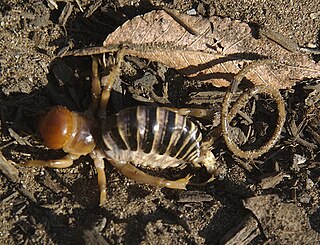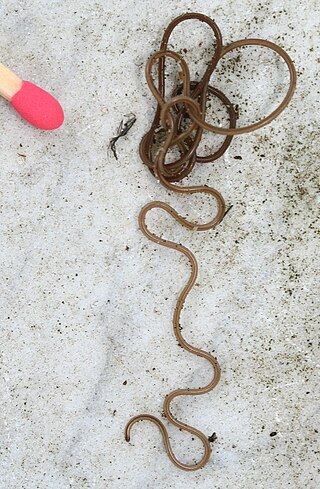
Nematomorpha are a phylum of parasitoid animals superficially similar to nematode worms in morphology, hence the name. Most species range in size from 50 to 100 millimetres, reaching 2 metres (79 in) in extreme cases, and 1 to 3 millimetres in diameter. Horsehair worms can be discovered in damp areas, such as watering troughs, swimming pools, streams, puddles, and cisterns. The adult worms are free-living, but the larvae are parasitic on arthropods, such as beetles, cockroaches, mantises, orthopterans, and crustaceans. About 351 freshwater species are known and a conservative estimate suggests that there may be about 2000 freshwater species worldwide. The name "Gordian" stems from the legendary Gordian knot. This relates to the fact that nematomorphs often coil themselves in tight balls that resemble knots.
Gordias was the name of at least two members of the royal house of Phrygia.

Gekkonidae is the largest family of geckos, containing over 950 described species in 64 genera. The Gekkonidae contain many of the most widespread gecko species, including house geckos (Hemidactylus), the tokay gecko (Gekko), day geckos (Phelsuma), the mourning gecko (Lepidodactylus), and dtellas (Gehyra). Gekkonid geckos occur globally and are particularly diverse in tropical areas.
Gordius, a Cappadocian by birth, was the instrument of Mithridates Eupator, king of Pontus, in his attempts to annex Cappadocia to Pontus. Gordius was employed by him, in 116 BC, to murder Ariarathes VI, king of Cappadocia. Gordius was afterwards tutor of a son of Mithridates, whom, after the murder of Ariarathes VII he made king of Cappadocia as Ariarathes IX. Gordius was sent as the envoy of Mithridates to Rome, and afterwards employed by him to engage Tigranes, king of Armenia, to attack Cappadocia, and expel Ariobarzanes I, whom the Romans made king of that country in 93 BC. Sulla restored Ariobarzanes in the following year, and drove Gordius out of Cappadocia. Gordius opposed Lucius Licinius Murena in the Battle of Halys, 82 BC.
Nicomedes III Euergetes was the king of Bithynia, from c. 127 BC to c. 94 BC. He was the son and successor of Nicomedes II of Bithynia.

Ariarathes VII Philometor ("mother-loving"), King of Cappadocia, was the first son of King Ariarathes VI of Cappadocia and his wife Laodice of Cappadocia. Ariarathes VII had an older sister called Nysa and a younger brother called Ariarathes VIII of Cappadocia.

The purple-shot copper is a butterfly in the family of the Lycaenidae or copper butterflies and in the genus of the Lycaena.

USS Gordius (ARL-36) was one of 39 Achelous-class landing craft repair ships built for the United States Navy during World War II. Named for Gordius, she was the only U.S. Naval vessel to bear the name.

Sphinx gordius, the apple sphinx, is a moth of the family Sphingidae. The species was first described by Pieter Cramer in 1780.

Juncus balticus is a species of rush known by the common name Baltic rush. It is a perennial flowering plant in the family Juncaceae. This plant can reach a height of about 75 cm. It is native to maritime areas of northern Britain, the Baltic and Scandinavia, western Europe, North America and western South America. It is available from specialist nurseries for landscaping and soil stabilization purposes.

Sphinx is a genus of moths in the family Sphingidae. The genus was erected by Carl Linnaeus in his 1758 10th edition of Systema Naturae.
Tertiapatus is an extinct genus of supposed onychophoran known from Dominican amber deposits. The only known species described is Tertiapatus dominicanus. Other authors have doubted its status as an onchyophoran, due to its arthropodized antennae and articulated exoskeleton, which suggests that it is likely an arthropod.
Succinipatopsis is an extinct genus, originally described as an onychophoran known from Eocene-aged Baltic amber. The only known species is Succinipatopsis balticus. However, other authors have doubted its status as an onchyophoran, due to its skin not closely resembling that of onchyophorans, and lacking any diagnostic characters of the group.

Gordius is a genus of worms in the phylum Nematomorpha, the horsehair worms. It was formerly treated as the only genus in the family Gordiidae, but the genus Acutogordius is now considered as distinct. The genus is distributed worldwide except for Antarctica, where no Nematomorpha have been recorded.
The Battle of Halys took place in 82 BC, during the Second Mithridatic War. Roman general Lucius Licinius Murena became very overconfident while campaigning against Pontus and ignored orders to cease operations there. He commanded two legions. Murena launched two raids into Pontic territory. After receiving orders from the Senate not to continue the war, Murena launched a third raid, beginning the Second Mithridatic War. At Halys River, the Romans spared a small Pontic army under general Gordius for too long. Gordius waited until King Mithradates VI arrived himself with the main Pontic army. The Romans were very ill-prepared for the battle. The combined Pontic army attacked the Roman forces on the opposite side of the river. The Mithridatic troops eventually forced their way across, forcing the Romans to retreat. Eventually in 81 B.C. Lucius Cornelius Sulla restored peace between Rome and Pontus.
Micropalaeosoma balticus is an extinct, fossil turbellarian flatworm known from Baltic amber of Kaliningrad, Russia, that lived approximately 40 million years ago. It measured approximately 1.5 mm in length and is the oldest and most complete flatworm fossil yet discovered.
Notoscyphus balticus is an extinct species of liverwort in the family Geocalycaceae. The species is solely known from the Middle Eocene Baltic amber deposits in the Baltic Sea region of Europe. The genus contains a total of thirteen extant species distributed across the northern hemisphere.

Gordius aquaticus is a species of Gordius.

Gordiidae is a family of parasitic horsehair worms belonging to the order Gordioidea.









